Vallance Surname Ancestry ResultsOur indexes 1000-1999 include entries for the spelling 'vallance'. In the period you have requested, we have the following 302 records (displaying 231 to 240): Single Surname Subscription | | | Buying all 302 results of this search individually would cost £1,694.00. But you can have free access to all 302 records for a year, to view, to save and print, for £100. Save £1,594.00. More... |
These sample scans are from the original record. You will get scans of the full pages or articles where the surname you searched for has been found. Your web browser may prevent the sample windows from opening; in this case please change your browser settings to allow pop-up windows from this site. Officers of the Royal Naval Volunteer Reserve: Sussex Division
(1904)
The Monthly Naval List for November 1904, printed By Authority for the Admiralty, contains these Lists of officers of the Royal Naval Volunteer Reserve by division - London, Clyde, Bristol, Mersey, and Sussex.VALLANCE. Cost: £4.00.  | Sample scan, click to enlarge
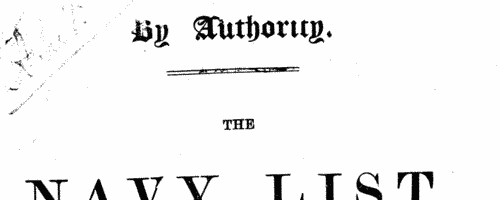
| Sub-Lieutenants of the Royal Naval Volunteer Reserve
(1904)
The Monthly Naval List for November 1904, printed By Authority for the Admiralty, contains these Seniority Lists of the officers of the Royal Naval Volunteer Reserve, giving full name, date of seniority, and division to which attached. A dagger indicates having completed a short course in gunnery, torpedo and signalling; a double dagger two or more such courses. A double S indicates an officer who had served in the Fleet for a short cruise of not less than one month.VALLANCE. Cost: £4.00.  | Sample scan, click to enlarge
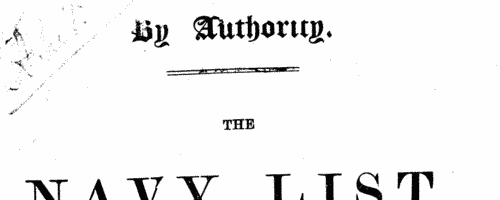
|  Queen's South Africa Medal: Royal Field Artillery: 74th Battery
(1901-1905) Queen's South Africa Medal: Royal Field Artillery: 74th Battery
(1901-1905)
The nominal roll for the Queen Victoria's South Africa Medal - awarded (after her death, in the event) to all who had served honourably in the various campaigns in the Boer War - was compiled from these returns from the individual units. Two sets of form were completed. The main one, as in the sample scan, dates from 1901 and gives regimental number, rank, and full name (surname first), followed by a series of columns relating to different actions - Belmont, Modder River, Paardeberg, Dreifontein, Wepener, Johannesburg, Diamond Hill, Belfast, Wittebergen, Defence of Kimberley, Relief of Kimberley, Defence of Mafeking, Relief of Mafeking, Cape Colony, Orange Free State, Transvaal, Rhodesia, Talana, Elandslaagte, Tugela Heights, Defence of Ladysmith, Relief of Ladysmith, Laing's Nek, and Natal; each entitled the man to a separate clasp to the medal, and a tick or a Yes in the appropriate column indicates the man's actual physical presence in that battle. A final column for remarks is important in those cases where the man was no longer in the unit, by removal, death or desertion. The second form that sometimes occurs was returned in 1905, and covers men entitled to the Second South African War Medal and Clasps. It lists men by number, rank and name, checks whether they had claimed the Queen's South Africa Medal, and then enquires as to their suitability as to three Colony Clasps, which could be awarded for service in the Cape, Orange Free, or Transvaal; whether entitled to Date Clasps (South Africa 1901 and South Africa 1902); whether also entitled to the King's South Africa Medal; any other corps in which served in South Africa; and remarks (such as becoming non-effective, forfeiture, &c.) WO 100/143VALLANCE. Cost: £8.00.  | Sample scan, click to enlarge

|  Queen's South Africa Medal: Royal Horse Artillery: A Battery
(1901-1905) Queen's South Africa Medal: Royal Horse Artillery: A Battery
(1901-1905)
The nominal roll for the Queen Victoria's South Africa Medal - awarded (after her death, in the event) to all who had served honourably in the various campaigns in the Boer War - was compiled from these returns from the individual units. Two sets of form were completed. The main one, as in the sample scan, dates from 1901 and gives regimental number, rank, and full name (surname first), followed by a series of columns relating to different actions - Belmont, Modder River, Paardeberg, Dreifontein, Wepener, Johannesburg, Diamond Hill, Belfast, Wittebergen, Defence of Kimberley, Relief of Kimberley, Defence of Mafeking, Relief of Mafeking, Cape Colony, Orange Free State, Transvaal, Rhodesia, Talana, Elandslaagte, Tugela Heights, Defence of Ladysmith, Relief of Ladysmith, Laing's Nek, and Natal; each entitled the man to a separate clasp to the medal, and a tick or a Yes in the appropriate column indicates the man's actual physical presence in that battle. A final column for remarks is important in those cases where the man was no longer in the unit, by removal, death or desertion. The second form that sometimes occurs was returned in 1905, and covers men entitled to the Second South African War Medal and Clasps. It lists men by number, rank and name, checks whether they had claimed the Queen's South Africa Medal, and then enquires as to their suitability as to three Colony Clasps, which could be awarded for service in the Cape, Orange Free, or Transvaal; whether entitled to Date Clasps (South Africa 1901 and South Africa 1902); whether also entitled to the King's South Africa Medal; any other corps in which served in South Africa; and remarks (such as becoming non-effective, forfeiture, &c.) WO 100/139VALLANCE. Cost: £8.00.  | Sample scan, click to enlarge

|  Queen's South Africa Medal: Royal Horse Artillery: G Battery
(1901-1905) Queen's South Africa Medal: Royal Horse Artillery: G Battery
(1901-1905)
The nominal roll for the Queen Victoria's South Africa Medal - awarded (after her death, in the event) to all who had served honourably in the various campaigns in the Boer War - was compiled from these returns from the individual units. Two sets of form were completed. The main one, as in the sample scan, dates from 1901 and gives regimental number, rank, and full name (surname first), followed by a series of columns relating to different actions - Belmont, Modder River, Paardeberg, Dreifontein, Wepener, Johannesburg, Diamond Hill, Belfast, Wittebergen, Defence of Kimberley, Relief of Kimberley, Defence of Mafeking, Relief of Mafeking, Cape Colony, Orange Free State, Transvaal, Rhodesia, Talana, Elandslaagte, Tugela Heights, Defence of Ladysmith, Relief of Ladysmith, Laing's Nek, and Natal; each entitled the man to a separate clasp to the medal, and a tick or a Yes in the appropriate column indicates the man's actual physical presence in that battle. A final column for remarks is important in those cases where the man was no longer in the unit, by removal, death or desertion. The second form that sometimes occurs was returned in 1905, and covers men entitled to the Second South African War Medal and Clasps. It lists men by number, rank and name, checks whether they had claimed the Queen's South Africa Medal, and then enquires as to their suitability as to three Colony Clasps, which could be awarded for service in the Cape, Orange Free, or Transvaal; whether entitled to Date Clasps (South Africa 1901 and South Africa 1902); whether also entitled to the King's South Africa Medal; any other corps in which served in South Africa; and remarks (such as becoming non-effective, forfeiture, &c.) WO 100/139VALLANCE. Cost: £8.00.  | Sample scan, click to enlarge

| Boys entering Fettes College, Edinburgh
(1906)
Fettes College, Edinburgh, was opened in 1870 under the terms of a trust 'for maintenance, education, and outfit of young people whose parents have either died without leaving sufficient funds for that purpose, or who, from innocent misfortune during their own lives, are unable to give suitable education to their children'. In 1923 this edition of the Fettes College Register was published; in it the compilers sought to set out for each boy who had attended the college a brief synopsis of what was known about his time at the school, his subsequent career, and date and place of death, or address as of 1923. Of course, for most of the boys entering the school in the early 20th century, their career was still ahead of them. After each name there is a letter in brackets indicating the house to which the pupil belonged - (C.) Carrington House; (G.) Glencorse House; (K.) Kimmerghame House; (M.) Moredun House; (S.) Schoolhouse. An asterisk indicates that the boy was a foundationer, i. e. supported by the foundation; a dagger that he was a foundation scholar. VIA. indicates Upper Form; Mods. Modern School; Army Cl., Army Class; S. P., School Prefect; xx. First Rugby Football Twenty; xv. First Rugby Football Fifteen; xx. cap. Caps occasionally given to the five (or fewer) next to the First Fifteen after 1875; xi. First Cricket Eleven; viii. Gymnastic Eight; Trs. Prizes and Exhib., Trustees' Prizes and Exhibitions; Govs. Prizes and Exhib., Governors' Prizes and Exhibitions; Schol., scholarship; M., married. Month and year of birth is given in square brackets.VALLANCE. Cost: £4.00.  | Sample scan, click to enlarge
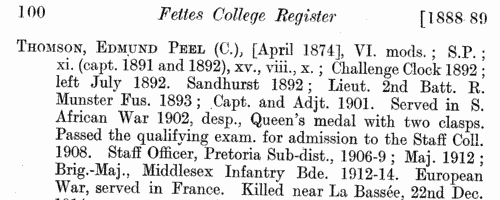
| Civil Servants and Office Holders
(1907)
The Imperial Calendar gives lists of officials and office-holders throughout England, Wales, Scotland and Ireland
VALLANCE. Cost: £4.00.  | Sample scan, click to enlarge
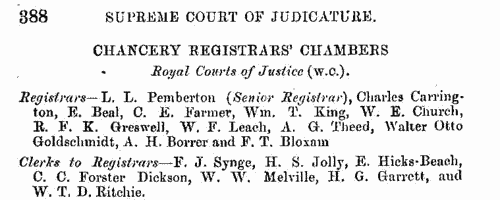
| Boys entering Marlborough College
(1910)
The public school at Marlborough in Wiltshire was founded in 1843. In 1952 this, 9th, edition of the college register was published, being a revision by L. Warwick James of the 8th edition (of 1936): but for the years before 1936 it does not merely repeat the 8th edition, because Warwick James was able to correct the 19th-century entries with information from newly-discovered letters and books from 1843 to 1853, and the school lists from 1844 onwards. The roll is arranged by year, and within each year by term of entrance, and then alphabetically by surname within each term. Each boy is assigned a number within the year: then his name is given, surname first, and, in brackets, his house. The houses within the college were called B1, B2, B3, C1, C2 and C3, and the Lower School (L Sch); the out college houses were Preshute, Priory, Cotton, Hermitage, Littlefield, Barton Hill, Summerfield and Upcot. Then there is given the boy's father's name (surname and initials) and address (at entrance), the boy's date of birth (b) and month of leaving (l). Where the boy represented the school at Rugby football (XV) or cricket (XI), in the rifle corps (VIII, or RC XI), that is indicated. There is a brief summary of achievements in later life, and, where known, and date of death or (in italics) address as in 1952. VALLANCE. Cost: £4.00.  | Sample scan, click to enlarge
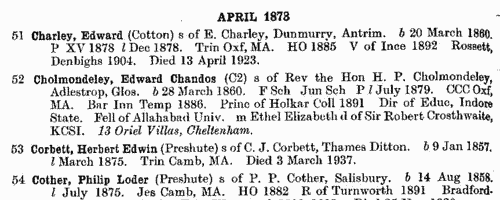
| Civil Servants and Office Holders
(1910)
The Imperial Calendar gives lists of officials and office-holders throughout England, Wales, Scotland and Ireland
VALLANCE. Cost: £4.00.  | Sample scan, click to enlarge
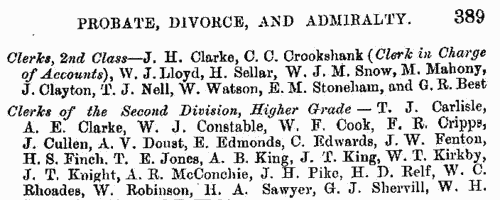
| Boys entering Marlborough College
(1911)
The public school at Marlborough in Wiltshire was founded in 1843. In 1952 this, 9th, edition of the college register was published, being a revision by L. Warwick James of the 8th edition (of 1936): but for the years before 1936 it does not merely repeat the 8th edition, because Warwick James was able to correct the 19th-century entries with information from newly-discovered letters and books from 1843 to 1853, and the school lists from 1844 onwards. The roll is arranged by year, and within each year by term of entrance, and then alphabetically by surname within each term. Each boy is assigned a number within the year: then his name is given, surname first, and, in brackets, his house. The houses within the college were called B1, B2, B3, C1, C2 and C3, and the Lower School (L Sch); the out college houses were Preshute, Priory, Cotton, Hermitage, Littlefield, Barton Hill, Summerfield and Upcot. Then there is given the boy's father's name (surname and initials) and address (at entrance), the boy's date of birth (b) and month of leaving (l). Where the boy represented the school at Rugby football (XV) or cricket (XI), in the rifle corps (VIII, or RC XI), that is indicated. There is a brief summary of achievements in later life, and, where known, and date of death or (in italics) address as in 1952. VALLANCE. Cost: £4.00.  | Sample scan, click to enlarge
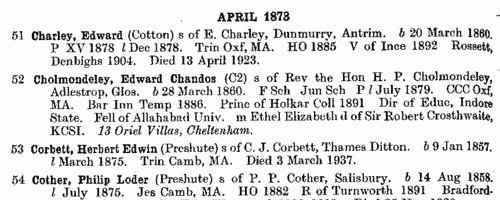
|
Research your ancestry, family history, genealogy and one-name study by direct access to original records and archives indexed by surname.
|













